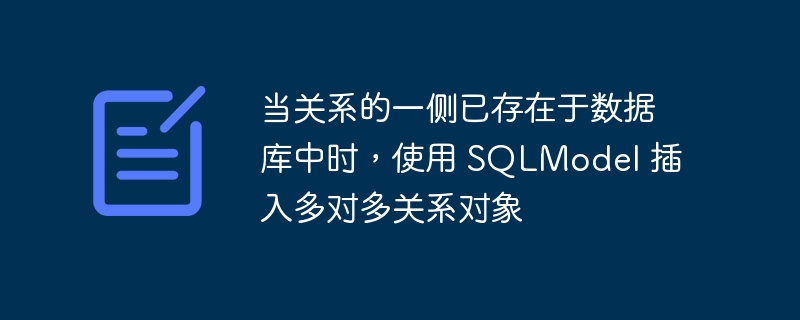
我正在尝试使用 sqlmodel 在数据库中插入记录,其中数据如下所示。 一个 house 对象,它有颜色和许多位置。 地点也将与许多房屋相关联。输入为:
[
{
"color": "red",
"locations": [
{"type": "country", "name": "netherlands"},
{"type": "municipality", "name": "amsterdam"},
],
},
{
"color": "green",
"locations": [
{"type": "country", "name": "netherlands"},
{"type": "municipality", "name": "amsterdam"},
],
},
]这是我正在尝试做的事情的可重现示例:
import asyncio
from typing import list
from sqlalchemy.ext.asyncio import create_async_engine
from sqlalchemy.orm import sessionmaker
from sqlmodel import field, relationship, sqlmodel, uniqueconstraint
from sqlmodel.ext.asyncio.session import asyncsession
database_url = "sqlite+aiosqlite:///./database.db"
engine = create_async_engine(database_url, echo=true, future=true)
async def init_db() -> none:
async with engine.begin() as conn:
await conn.run_sync(sqlmodel.metadata.create_all)
sessionlocal = sessionmaker(
autocommit=false,
autoflush=false,
bind=engine,
class_=asyncsession,
expire_on_commit=false,
)
class houselocationlink(sqlmodel, table=true):
house_id: int = field(foreign_key="house.id", nullable=false, primary_key=true)
location_id: int = field(
foreign_key="location.id", nullable=false, primary_key=true
)
class location(sqlmodel, table=true):
id: int = field(primary_key=true)
type: str # country, county, municipality, district, city, area, street, etc
name: str # amsterdam, germany, my street, etc
houses: list["house"] = relationship(
back_populates="locations",
link_model=houselocationlink,
)
__table_args__ = (uniqueconstraint("type", "name"),)
class house(sqlmodel, table=true):
id: int = field(primary_key=true)
color: str = field()
locations: list["location"] = relationship(
back_populates="houses",
link_model=houselocationlink,
)
# other fields...
data = [
{
"color": "red",
"locations": [
{"type": "country", "name": "netherlands"},
{"type": "municipality", "name": "amsterdam"},
],
},
{
"color": "green",
"locations": [
{"type": "country", "name": "netherlands"},
{"type": "municipality", "name": "amsterdam"},
],
},
]
async def add_houses(payload) -> list[house]:
result = []
async with sessionlocal() as session:
for item in payload:
locations = []
for location in item["locations"]:
locations.append(location(**location))
house = house(color=item["color"], locations=locations)
result.append(house)
session.add_all(result)
await session.commit()
asyncio.run(init_db())
asyncio.run(add_houses(data))问题是,当我运行此代码时,它尝试将重复的位置对象与房屋对象一起插入。
我希望能够在这里使用 relationship,因为它使访问 house.locations 变得非常容易。
但是,我无法弄清楚如何阻止它尝试插入重复的位置。理想情况下,我有一个映射器函数来执行 get_or_create 位置。
我所见过的最能实现这一点的是 sqlalchemy 的关联代理。但看起来 sqlmodel 不支持这一点。
有人知道如何实现这一目标吗?如果您知道如何使用 sqlalchemy 而不是 sqlmodel 来完成此操作,我有兴趣查看您的解决方案。我还没有开始这个项目,所以如果它能让我的生活更轻松的话,我不妨使用 sqlalchemy。
我还尝试使用 sa_relationship_kwargs 进行调整,例如
sa_relationship_kwargs={
"lazy": "selectin",
"cascade": "none",
"viewonly": "true",
}但这会阻止将关联条目添加到 houselocationlink 表中。
任何指示将不胜感激。即使这意味着完全改变我的方法。
谢谢!
正确答案
我正在编写这个解决方案,因为您提到您愿意使用 sqlalchemy。正如您所提到的,您需要关联代理,但您还需要“唯一对象”。我已将其调整为异步查询(而不是同步)功能,与我的个人偏好保持一致,所有这些都没有显着改变逻辑。
import asyncio
from sqlalchemy import UniqueConstraint, ForeignKey, select, text, func
from sqlalchemy.orm import DeclarativeBase, mapped_column, Mapped, relationship
from sqlalchemy.ext.asyncio import AsyncSession, create_async_engine
from sqlalchemy.ext.associationproxy import AssociationProxy, association_proxy
class Base(DeclarativeBase):
pass
class UniqueMixin:
cache = {}
@classmethod
async def as_unique(cls, session: AsyncSession, *args, **kwargs):
key = cls, cls.unique_hash(*args, **kwargs)
if key in cls.cache:
return cls.cache[key]
with session.no_autoflush:
statement = select(cls).where(cls.unique_filter(*args, **kwargs)).limit(1)
obj = (await session.scalars(statement)).first()
if obj is None:
obj = cls(*args, **kwargs)
session.add(obj)
cls.cache[key] = obj
return obj
@classmethod
def unique_hash(cls, *args, **kwargs):
raise NotImplementedError("Implement this in subclass")
@classmethod
def unique_filter(cls, *args, **kwargs):
raise NotImplementedError("Implement this in subclass")
class Location(UniqueMixin, Base):
__tablename__ = "location"
id: Mapped[int] = mapped_column(primary_key=True)
name: Mapped[str] = mapped_column()
type: Mapped[str] = mapped_column()
house_associations: Mapped[list["HouseLocationLink"]] = relationship(back_populates="location")
__table_args = (UniqueConstraint(type, name),)
@classmethod
def unique_hash(cls, name, type):
# this is the key for the dict
return type, name
@classmethod
def unique_filter(cls, name, type):
# this is how you want to establish the uniqueness
# the result of this filter will be the value in the dict
return (cls.type == type) & (cls.name == name)
class House(Base):
__tablename__ = "house"
id: Mapped[int] = mapped_column(primary_key=True)
name: Mapped[str] = mapped_column()
location_associations: Mapped[list["HouseLocationLink"]] = relationship(back_populates="house")
locations: AssociationProxy[list[Location]] = association_proxy(
"location_associations",
"location",
# you need this so you can directly add ``Location`` objects to ``House``
creator=lambda location: HouseLocationLink(location=location),
)
class HouseLocationLink(Base):
__tablename__ = "houselocationlink"
house_id: Mapped[int] = mapped_column(ForeignKey(House.id), primary_key=True)
location_id: Mapped[int] = mapped_column(ForeignKey(Location.id), primary_key=True)
location: Mapped[Location] = relationship(back_populates="house_associations")
house: Mapped[House] = relationship(back_populates="location_associations")
engine = create_async_engine("sqlite+aiosqlite:///test.sqlite")
async def main():
data = [
{
"name": "red",
"locations": [
{"type": "country", "name": "Netherlands"},
{"type": "municipality", "name": "Amsterdam"},
],
},
{
"name": "green",
"locations": [
{"type": "country", "name": "Netherlands"},
{"type": "municipality", "name": "Amsterdam"},
],
},
]
async with engine.begin() as conn:
await conn.run_sync(Base.metadata.create_all)
async with AsyncSession(engine) as session, session.begin():
for item in data:
house = House(
name=item["name"],
locations=[await Location.as_unique(session, **location) for location in item["locations"]]
)
session.add(house)
async with AsyncSession(engine) as session:
statement = select(func.count(text("*")), Location)
assert await session.scalar(statement) == 2
statement = select(func.count(text("*")), House)
assert await session.scalar(statement) == 2
statement = select(func.count(text("*")), HouseLocationLink)
assert await session.scalar(statement) == 4
asyncio.run(main())您可以注意到断言确实通过,没有违反唯一约束,也没有多次插入。我留下了一些内联注释,其中提到了这段代码的“关键”方面。如果多次运行此代码,您会注意到仅添加了新的 house 对象和相应的 houselocationlink,而没有添加新的 location 对象。对于每个键值对,只会进行一次查询来缓存此行为。



